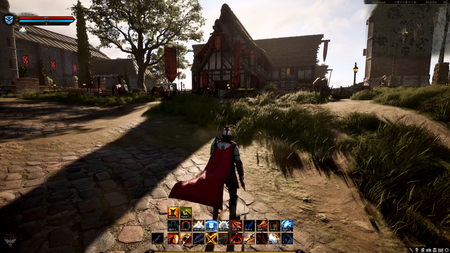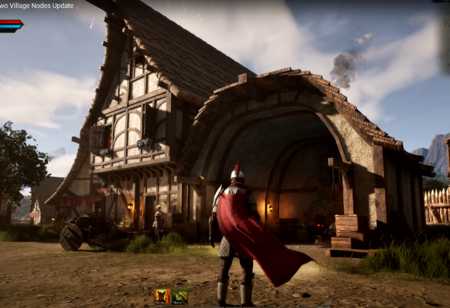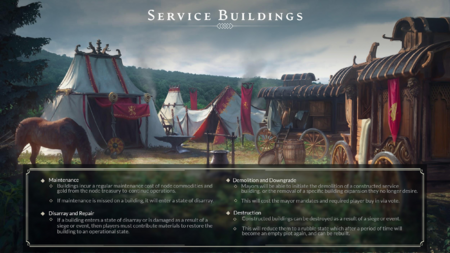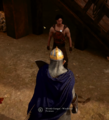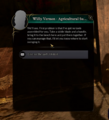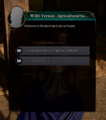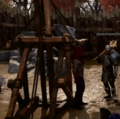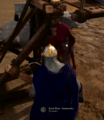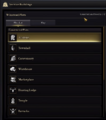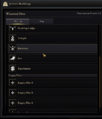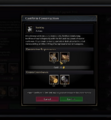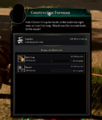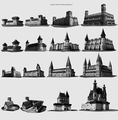Service buildings
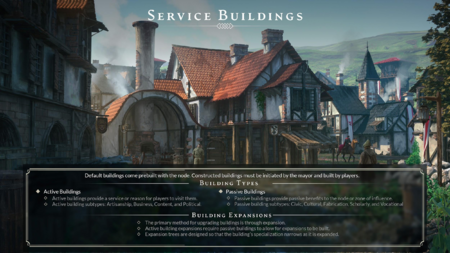
The important thing with the service building system for us is that it's a way to shape your node like a character; and to give you an exclusive niche that you can carve out in the world; or a niche that you fight over. If you go down this weaponsmithing path and you build your node to be this mecca of weaponsmithing and the node three doors down builds it, there's reason for you to conflict over it. They're taking your business. Or maybe you are in a zone and there isn't a weaponsmithing thing anywhere near you, and you do want to start to carve that path for yourself to make your node a place people visit and come to.[2] – Chris Justo
Service buildings within a node are either default buildings that come with the node, or they are constructed buildings, which are initiated by the mayor and built by players.[1][2][3][4][5][6][7] Service buildings are further broken down into two main types:[1][2]
- Active service buildings are service buildings that players directly interact with. These are further broken down into Artisanship, Business, Content, and Political categories.[1][2]
- Passive service buildings provide passive benefits to the node or its zone of influence. These buildings are broken down into Civic, Cultural, Fabrication, Scholarly, and Vocational.[1][2]
- Constructed service buildings are available to every type of node in every location. Where the uniqueness comes in is in some of the default buildings like your node-type building.[8] – Chris Justo
Service buildings are upgraded by expansions, which are unlocked through the placement of passive service buildings.[1][2]
- Building expansions unlock higher tier workstations at the cost of dedicating service building plots.[9][5]
- Node service building expansions specialize the building through a tech tree based on the stage of the node.[10][11]
Service buildings incur a regular maintenance cost of node commodities and gold from the node treasury in order to continue operations.[1][12]
Default service buildings
Default service buildings are service buildings that come pre-built with a node. Some of these buildings are unique based on the type of node. Others may be present based on the acquisition of relics.[8]
List of default service buildings
- Default service buildings
Constructible service buildings
Once materials are contributed to it and it's ready to finish, there's gonna be any variable from like 15 to 20 minutes to even a couple of days for it to finish constructing, depending on the power that the building offers to the players.[15] – Chris Justo
Constructible service buildings are service buildings that are available to every type of node in every location, and can be placed in any available building plot in a node.[16][8][17]
- Mayors decide which buildings are placed in which plot (via a node map UI, or physically walking the node).[18] They may select any empty plot in the node but their choices may limit them from placing other buildings in the future.[16][9][6][5]
- The plots in a node are predefined but the plots are universal. So you can put any constructed service building in any plot.[17] – Chris Justo
- Service buildings become objectives during events, node sieges and node wars. It is therefore important for mayors to select defensible locations for the most important service buildings.[19]
- When it comes to either events, or sieges against the node, and even wars, those building locations also serve as objective locations as well; and there is a varying degree of footprint and level design that's associated with access to those plot locations. So if your smithy that has your workstation to build the T5 stuff is next to the door, there's a difference there in strategy.[17] – Steven Sharif
- When the constructible service building types are determined by the mayor, they can initiate buy orders to bring resources into the node in order to construct the buildings.[1][20][21][5] In addition to buy orders, citizens will be required to come to the node to directly contribute resources to a construction foreman NPC to aid in building construction.[22]
- This is our way of ensuring that citizens want the thing that the mayor is asking them to do, or is spending resources on. So if you're a mayor and you're just like 'I'm going to build a bunch of this building that no one wants' then players aren't going to contribute to it and they're not going to get built.[22] – Chris Justo
- Once all resources have been contributed to a building, it will take between 15 minutes to a couple of days for construction to complete depending on the type and tier of building.[23][15] Construction times may be reduced through node policies.[23]
- Different mayors may destroy and construct different service buildings within their node. Destroying buildings has a node mandate cost and will require player buy-in via a vote.[1][12][5]
- Materials contributed toward building a node building are lost if the mayor decides to scrap the project.[24]
List of constructible service buildings
Service building expansions
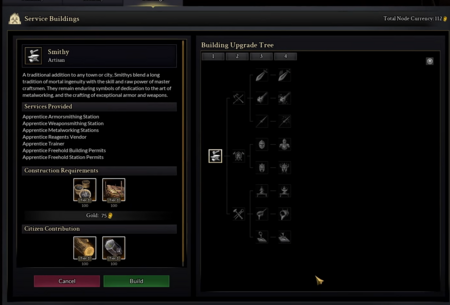
Default buildings they specialize as they expand. So this isn't like a traditional skill tree, it's exclusionary, more like a tech tree. So selecting the next upgrade for it will lock out the other two paths. So as you get better with the building it will continue to narrow, which allows lots of nodes to carve out lots of niches in the world.[10] – Chris Justo
Service buildings are upgraded by expansions, which are unlocked through the placement of passive service buildings.[1][2]
- Service building expansions allow buildings to be specialized via a tech tree, such as moving from a generalized Blacksmithing building to an Armor smithing building, then finally toward a building that specializes in Plate armor.[10][2][11]
- To upgrade your building, you choose expansions, you build passive buildings to allow you to unlock those expansion slots and just a little- basically specialize your service building down a path; and the building specialization will narrow down a specific path. So you might start as a generalized Blacksmith building and then you'll specialize towards maybe armorsmithing, and then towards specifically, like plate armor through the expansion tree.[2] – John Collins
- Building expansions unlock higher tier workstations at the cost of dedicating service building plots. Lower stage nodes can achieve higher tier service buildings by dedicating a majority of their service plots to that path. Mayors decide how to specialize their node. Once they choose certain things they won't be able to choose other things.[9][6][5]
- The pathway of upgrades is exclusionary. So when I choose a path down a particular building type in order to reach a tier five benefit: when I eventually reach a higher stage, or even if I'm lower stage and want to dedicate a majority of my service plots toward one particular crafting building; like I may get a very top tier workstation as a result, even if I'm still a Village node. It's like I'm the village node that makes the T5 swords because I've dedicated all of my plots to that.[9] – Steven Sharif
- Vassal nodes can benefit from the types of service buildings present in their regent node.[26]
- You might have a parent node, or a Regent node, that has a vassalship over your node and you're getting benefits conferred to you through either the prerequisite of the building types that you can construct as well to make a bit more headway there.[9] – Steven Sharif
Service building tech trees
Service building upkeep
Service buildings incur a regular maintenance cost of node commodities and gold from the node treasury in order to continue operations.[1][12]
- Building maintenance is auto-paid from the treasury in order of the most valuable buildings first.[1][12]
- If maintenance is not paid, or a building is damaged as the result of an event or siege, the building will enter a state of disarray.[1][12] Any NPCs or services offered by that building will not be available until the building is repaired.[4][27]
- Players must contribute materials to repair disarrayed buildings and restore them to an operational state.[1][12][11][27][28]
- Larger more advanced buildings will require more resources to repair them. In-node housing will likely require the least resources to repair.[29]
- Previously building repair was restricted to node-citizens.[27][28]
Service building destruction
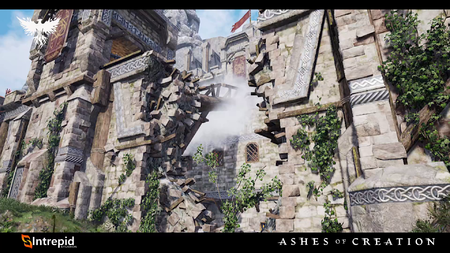
You could be more precision oriented in the decision to attack a city. Let's say it's a rival node that's trying to reach a node stage five or something and you want to disable their ability for the religious system to progress so you target the temple during the attack, or you want to disable their scholars academy from reaching a higher level so that your nodes can; or you want to disable multiple buildings that allow for experience and quests to be undertaken by its citizenship, which prevents them from keeping up in pace of experience gained with your node. These can be more precision oriented and don't have to effectualize an actual takeover of the node.[31] – Steven Sharif
Node buildings (including player housing) have hit points and can be damaged or destroyed by different systems.[11][27]
- NPC-driven events that are a response to story arcs or node atrophy.[11]
- Node sieges and node wars.[11]
- Attackers may not be capable of destroying a node during a siege. Instead they may carry out precision attacks to disable specific service-oriented buildings within the node. These buildings can be targeted with siege weapons and bombs.[31]
- Hazardous events such as tornadoes or hurricanes.[32][11]
- Mayors have the ability to demolish constructed node buildings. This will have a node mandate cost and will require player buy-in via a vote.[1][12]
- Mayors will also have the ability, if they want, to demolish constructed buildings. So if they if they so choose they can destroy a building if they don't think it's needed anymore. But this will have mandate cost and a player buy-in votes. So we want to make sure that [the] mayor can't just go and blow up the whole node if they're trying to grief or something. So this is very important and impactful decision.[1][12] – John Collins
If building maintenance is not paid, or a building is damaged as the result of an event or siege, the building will enter a state of disarray.[1][12] Any NPCs or services offered by that building will not be available until the building is repaired.[4][27]
- Players must contribute materials to repair disarrayed buildings and restore them to an operational state.[1][12][11][27][28]
If a node siege is successful, or if buildings otherwise take significant damage, they are destroyed and appear as rubble on the plot they occupied.[1][12][11]
- Node governments must clear any rubble on plots before any buildings can be reconstructed. Any prerequisites for the building reconstruction must be satisfied beforehand.[11]
- Buildings also live within a prerequisite system. So in order to build down the tech tree of what these buildings provide, as the node grows larger to access stronger building types, you may get a kink in that chain if it's destroyed and you'll have to stand that back up in order to support the service again.[11] – Steven Sharif
- If the node is destroyed by a node siege, the debris field will contain spoils that are lootable by attackers or defenders.[33][34][35][27][36][37]
- Player housing that is destroyed during a node siege can no longer be sold.[38] Furnishing and decorations are retained and can be placed again later.[38][39][40]
Node layout and style
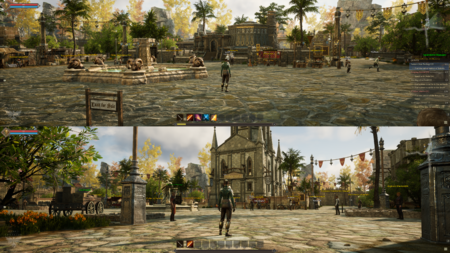
The layout and architecture within a Node’s development area are determined by influential race. For example, a stage 3 Node with the majority of player contribution being Py'rai would have a Py'rai village with Py'rai architecture. Most NPCs would be Py'rai elves, and offer questlines within the Py'rai narrative.[41] – Margaret Krohn
Each player’s contributed experience is flagged with their character race and other identifiers. When a Node advances, the race with the highest experience contribution determines the Node’s style and culture. This style and culture change can happen at every Node Stage. For example, if a Node advances to Level 2 - Encampment Stage and 51% of all experience was earned by Ren’Kai players, the Node will be a Level 2 Ren’Kai Node. If that same Node advances to a Level 3 - Village Stage Node, but the Py'Rai contributed 62% of all the experience earned, then the Node will be a Level 3 Py'Rai Node.[42] – Margaret Krohn
Node layout and style is determined by several factors:[43][44]
- The way that the node system is built is that they can exist across a spread of 18 biomes, but at the same time have to represent the cultural influence of these cultures that are intrinsically a part of a specific biome.[45] – Steven Sharif
- Environment (biome) and location of the node.[45][43][44]
- Nodes will adjust the local topography to fit the aesthetic and mechanical requirements of the node.[46]
- Currently the way that the platform system is set up, is it's capable of adjusting the topography of the node's footprint, regardless of the surrounding terrain. So the reason for that is we want to have flexibility in the presentation of the node's layout and how it is essentially both from an aesthetic standpoint as well as a mechanical standpoint with node sieges- how it's constructed and that construction should have the ability to take on a variance of different types of topography. So it shouldn't be dependent on the surrounding area. Now that's not to say that the surrounding area isn't going to have some influence over. So for example... we're experimenting a little bit with the platform tech and putting up a node up against the side of a mountain or on the edge of a cliff or something that has a beautiful vista. Those are things that we're going to test out obviously as we continue to work on the node tool and how that platform system works, but the idea is to have the node independent of the surrounding terrain.[46] – Steven Sharif
- Some parts are determined by the area it's in. Some parts are determined by the type it is. Some parts are determined by the race it is; and then the rest of it is determined by the mayor.[44] – Jeffrey Bard
- Race that contributed the highest percentage to the node's advancement will alter the racial appearance of its buildings, NPCs, and props.[47][48][43][42][44][49][50]
- All nodes, whether they're associated with a castle or associated with normal node structure, has cultural influences that replicate over to the buildings that are produced and the NPCs that are present.[52] – Steven Sharif
- The rest is determined by the node's mayor.[44]
- It should be possible for a node to complete several building projects within a mayor's one month term in office.[53]
- Q: How long would you say it will take players on average to fill/build up a node completely from wilderness to metropolis?
- A: It's one thing to get a node to a certain level: it's another thing to develop the node; and I can't really give you an on-average expectation, because there's a lot of variables at play. There's how many citizens does the node have attracted to it; what's the type of traffic that the node is attracting to it based on things like its tax rates, or the specialization that it chose to spec into, based on the building types it's chosen to build. All of those things are variables that can affect the quote-unquote "average build-out time" of a particular node. So it's difficult to give you an average when there's so many variables along those lines. But the idea is that if there is a particular project that players are interested in in developing based on the node stage, that they would have the ability to complete several of those projects as within a single term of a mayor; and a term of a mayor is one month.[53] – Steven Sharif
Visuals
2023-12-02 2023-11-01 2023-09-13 2023-09-05 2023-09-04 2020-03-24 2018-04-01
See also
References
- ↑ 1.00 1.01 1.02 1.03 1.04 1.05 1.06 1.07 1.08 1.09 1.10 1.11 1.12 1.13 1.14 1.15 1.16 1.17 1.18 1.19 Blog: Development Update with Village Node.
- ↑ 2.00 2.01 2.02 2.03 2.04 2.05 2.06 2.07 2.08 2.09 2.10 Livestream, August 31, 2023 (50:25).
- ↑ Video, August 31, 2023 (2:59).
- ↑ 4.0 4.1 4.2 Interview, July 9, 2023 (1:32:45).
- ↑ 5.0 5.1 5.2 5.3 5.4 5.5 Livestream, May 19, 2017 (33:57).
- ↑ 6.0 6.1 6.2 Livestream, January 20, 2018 (38:17).
- ↑ Livestream, 2018-04-8 (PM) (51:49).
- ↑ 8.0 8.1 8.2 Livestream, August 31, 2023 (56:18).
- ↑ 9.0 9.1 9.2 9.3 9.4 Livestream, August 31, 2023 (52:56).
- ↑ 10.0 10.1 10.2 10.3 Video, August 31, 2023 (34:37).
- ↑ 11.00 11.01 11.02 11.03 11.04 11.05 11.06 11.07 11.08 11.09 11.10 Livestream, March 31, 2022 (1:13:00).
- ↑ 12.00 12.01 12.02 12.03 12.04 12.05 12.06 12.07 12.08 12.09 12.10 Livestream, August 31, 2023 (57:23).
- ↑ Video, August 31, 2023 (49:05).
- ↑ X.com - From blueprint to bustling Node, watch how Service Buildings are made in this short time-lapse video!
- ↑ 15.0 15.1 15.2 Video, August 31, 2023 (38:50).
- ↑ 16.0 16.1 Livestream, August 31, 2023 (2:12:29).
- ↑ 17.0 17.1 17.2 Livestream, August 31, 2023 (55:21).
- ↑ Livestream, August 31, 2023 (2:11:54).
- ↑ Livestream, August 31, 2023 (53:33).
- ↑ Livestream, August 31, 2023 (59:43).
- ↑ Interview, July 8, 2020 (1:04:05).
- ↑ 22.0 22.1 Video, August 31, 2023 (36:14).
- ↑ 23.0 23.1 Livestream, August 31, 2023 (2:13:22).
- ↑ Livestream, July 30, 2021 (1:10:09).
- ↑ Video, August 31, 2023 (46:54).
- ↑ Livestream, August 31, 2023 (54:44).
- ↑ 27.0 27.1 27.2 27.3 27.4 27.5 27.6 Interview, July 8, 2020 (57:46).
- ↑ 28.0 28.1 28.2 Livestream, November 22, 2019 (17:59).
- ↑ Interview, July 8, 2020 (59:38).
- ↑ Livestream, October 31, 2019 (36:20).
- ↑ 31.0 31.1 Livestream, November 22, 2019 (16:56).
- ↑ Forums - Livestream Q&A 2022-08-26.
- ↑ Interview, July 9, 2023 (1:36:24).
- ↑ Livestream, October 14, 2022 (52:31).
- ↑ Podcast, September 29, 2021 (14:21).
- ↑ Livestream, April 30, 2020 (1:14:44).
- ↑

- ↑ 38.0 38.1 Livestream, June 26, 2020 (1:02:12).
- ↑ Livestream, July 18, 2017 (40:14).
- ↑ Livestream, November 17, 2017 (47:10).
- ↑ Blog - Know Your Nodes - The Basics.
- ↑ 42.0 42.1 42.2 Blog - Know Your Nodes - Advance and Destroy.
- ↑ 43.0 43.1 43.2 Livestream, October 30, 2020 (39:17).
- ↑ 44.0 44.1 44.2 44.3 44.4 44.5 Livestream, September 27, 2018 (53:06).
- ↑ 45.0 45.1 Livestream, February 25, 2022 (41:00).
- ↑ 46.0 46.1 Livestream, February 26, 2021 (1:12:18).
- ↑ Livestream, March 31, 2022 (4:57).
- ↑ Podcast, April 11, 2021 (29:47).
- ↑ Interview, May 11, 2018 (54:34).
- ↑ Livestream, May 26, 2017 (21:23).
- ↑ Podcast, April 11, 2021 (23:36).
- ↑ 52.0 52.1 Interview, May 11, 2018 (47:27).
- ↑ 53.0 53.1 Livestream, July 29, 2022 (1:13:09).
